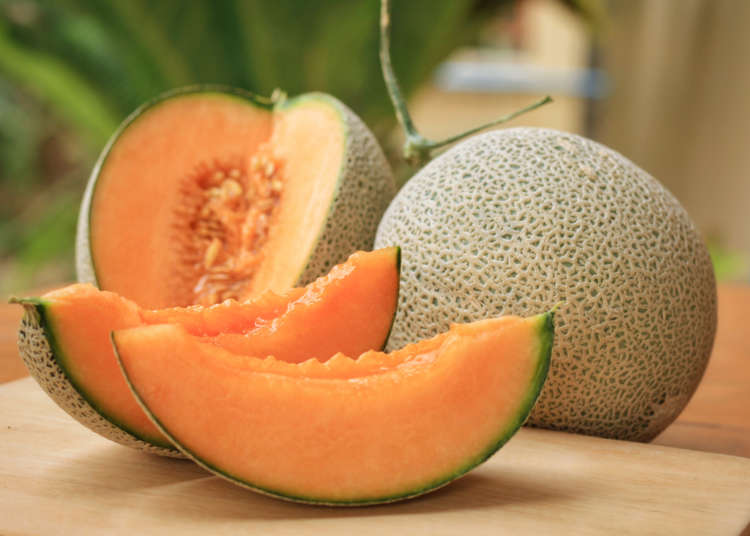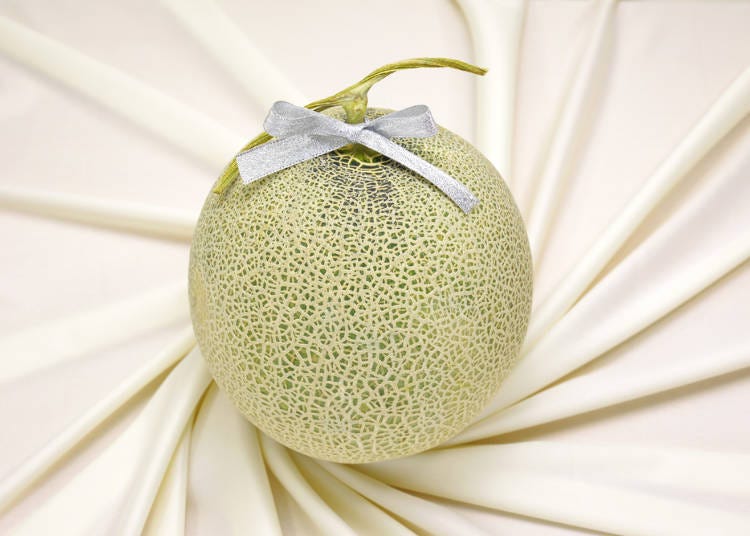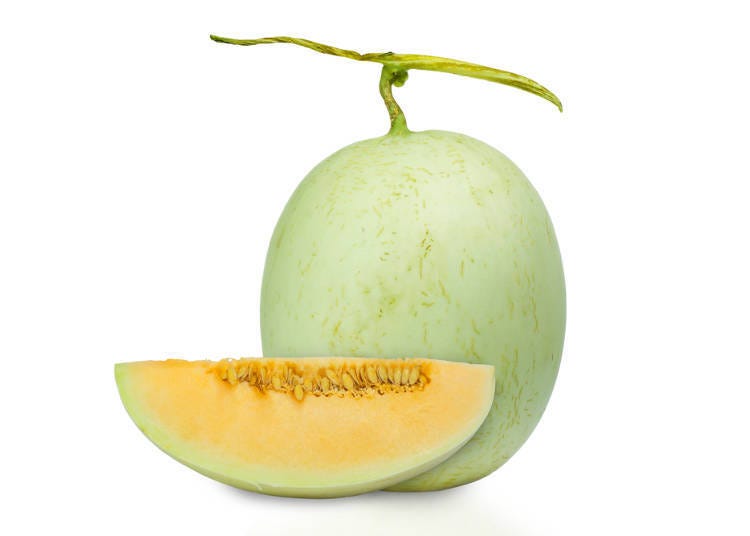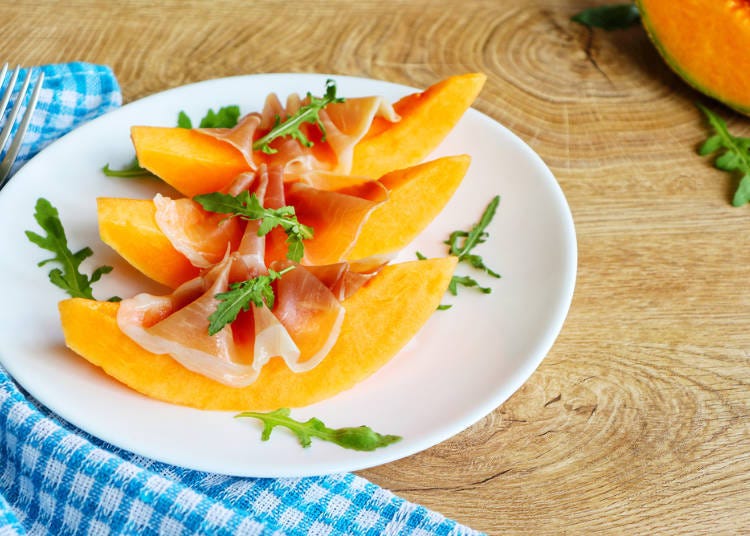
Why Japanese Melons Are Must-Eat Fruits in Japan (And How To Really Enjoy Them)!
- Written by: WESTPLAN
In recent years the deliciousness of Japanese fruit has been attracting attention overseas. Among the sought-after fruits, melons have gained popularity as a high-class fruit.
Various kinds of melons are grown throughout Japan, and prices range from inexpensive ones for everyday consumption to high-end melons intended for gift-giving.
Here’s everything you need to know about Japanese melons, from the different varieties to when and how to eat them.
- Table of Contents
-
- 1. What kind of melons are grown in Japan?
- 2. Understanding melon grades and ratings
- 3. Typical Japanese melon types
- Earls melon
- Ibara King melon
- Yubari Melon
- Lupia Red
- Prince melon
- 4. How to choose the most delicious melons
- 5. The best way to eat Japanese melons and skillfully cut them
- 6. Main ways to enjoy melons
- 7. Summary
1. What kind of melons are grown in Japan?
Ibaraki Prefecture has the largest growing area and the highest production of melons, with about 40,000 tons harvested annually. Kumamoto and Hokkaido produce about 20,000 tons, and the rest of these relatively easy-to-grow fruits are cultivated from Tohoku to Kyushu.

Japanese muskmelons, considered a high-class fruit, are both fragrant and delicious and characterized by the net-like pattern of their surface. Varieties with green flesh include Earls melon and Andean melon, while Yubari melons and Lupia Red melons have orange flesh.

Smooth-skinned melons without an external mesh pattern include Home Run melons with whitish flesh and Prince melons with flesh that gradates from yellowish-green on the outside to orange in the center.
In terms of cultivation methods, some are grown in greenhouses, and others are not. Through specific temperature and watering control, greenhouse-grown melons are manipulated to grow only one fruit per plant.
Earls melon is grown through this cultivation method. Some Andean and Yubari melons are also grown in greenhouses. Prince and Home Run melons are grown in vinyl-covered “tunnels” and are cheaper than greenhouse-grown melons.
While visiting Japan, you can eat premium melons from famous production areas like Yubari melons from Hokkaido, Ibaraki melons from Ibaraki, and Earls melons from Shizuoka. In addition, home Run melons and Prince melons are also recommended as they can be bought at a reasonable price.
2. Understanding melon grades and ratings

Domestic Japanese melons are rated by grade and rank, with strict standards set by distributors. Grades include “particularly excellent,” “excellent,” “superior,” “good,” etc., based on sugar content, ripeness, appearance (shape, lack of blemishes, etc.), density and fineness of the surface net pattern, and color.
The standards for size and weight rank are noted as S (small), M (middle), L (large), 2L (or LL), etc. In addition, Japanese melons are generally displayed by grade and rank such as “Excellent L” or “Good 2L.”
3. Typical Japanese melon types
These are types of melons you’ll typically find in Japan.
Earls melon

Earls melon is a high-class melon with juicy green flesh and exceptional sweetness gained by carefully growing a single fruit on each vine. Called “the king of melons,” they are often given as gifts. Produced in Shizuoka, Ibaraki, Kumamoto, and other parts of the country, they are in season from early August to early September.
Ibara King melon

The Ibara King is a variety developed in Ibaraki prefecture, characterized by its smooth texture, refreshing sweetness, and elegant aroma. The flesh is green with high sugar content. In season from early May to early June, they are sometimes shipped in late April, and people eagerly look forward to their luxurious taste.
Yubari Melon

Yubari melons are grown exclusively in Yubari, Hokkaido. Their bright orange flesh is soft, sweet, juicy, and melts in your mouth. Yubari melons are in season from late June to early August. When the rind turns pale yellow, and the stem dies, they’re ready to be eaten, but they ripen faster than other melons, so make sure to avoid over-ripening.
Lupia Red

Lupia Red melons have a beautiful finely netted surface. Their rind is thin, and the orange flesh is firm and long-lasting, but it’s soft and easy to eat when ripe. The Lupia Red season is from July to September. Those grown in Hokkaido are sold with stems attached, while those from Ibaraki are shipped without.
Prince melon

The Prince melon was developed in Japan and first sold in 1961, gaining immediate popularity in average households due to its low price. Muskmelons are often 5,000 yen or more for a 1-kilogram melon, whereas Prince melons are smaller at only 600 to 700 grams but only cost about 1,000 yen.
The flesh is yellowish-green on the outside near the skin and orange as it gets closer to the center. The scent is light, but they’re very sweet and juicy. Prince melons are grown in Kumamoto, Yamagata, Fukui, Hokkaido, and other areas, with their season varying slightly depending on the area but generally taking place from May to June.
4. How to choose the most delicious melons

Whether the melon has a netted surface or not, look for those that are not quite spherical but well-proportioned and symmetrical, with no deformities, scratches, discoloration, or blemishes. You’ll have a melon that’s sweet and delicious. Moreover, those that feel heavier have thicker, juicier flesh.
Also, keep in mind that since melons are harvested and before they ripen, many found on supermarkets shelves are relatively immature. Therefore, those with a strong scent when sold may be overripe and should be avoided.
It is said that melons with a netted surface are most delicious when the net is raised and evenly distributed. The fineness of the net, however, does not seem to affect the sweetness of the melon.
5. The best way to eat Japanese melons and skillfully cut them

Generally, melons reach store shelves 4 to 5 days after being shipped from their production area, so it is best to eat them 2 to 3 days after purchase. To ripen, store at room temperature – not in the refrigerator.
Gently press the base of the melon (directly opposite the stem), and when it is soft, the melon is ripe enough to eat. Refrigerating the melon 2-3 hours before eating will make the taste stand out and provide just the right amount of coolness.
Greenhouse-grown melons are shipped year-round, but most are available from early May to July, which is the best time to eat melons.
To slice a melon, first cut off the stem, which is bitter.

After washing the stem’s bitterness off the knife, cut the fruit vertically.

Then scoop out the seeds with a spoon.

Finally, if you cut each slice horizontally into smaller segments, it will be easier to eat with a fork.
6. Main ways to enjoy melons

Melons are usually purchased at supermarkets and department store fruit counters. However, if you plan to give one as a gift, fruit specialty stores or department stores where it can be boxed and wrapped are recommended.
You can pick melons yourself at some farms, and while the season differs by region, many are open from June to September. The farms offer different ways to enjoy melons, from harvesting to all-you-can-eat servings, so check in advance and make a reservation before visiting.

If you don’t want to eat a whole melon, we recommend buying ready-to-eat melon slices at a department store or supermarket. Some restaurants serve prosciutto on cut melons as an hors d’oeuvre or melons for dessert.

Most melons are available around June. At that time of year, sweets using melons will appear as special menu items at cafes, restaurants, and other places. In addition to topping parfaits and cakes, other melon-centered desserts like melon sorbet or melon and whipped cream are also popular.

The fragrant sweetness of melons is also processed into chocolate and other sweets. So you’ll definitely want to try the melon-flavored sweets sold at supermarkets and convenience stores.
7. Summary
There are many other types of Japanese melons in addition to those listed here. So be sure to make the sweetly scented, melt-in-your-mouth texture of these delicious, juicy fruits a part of any special occasion!
*Photos are sample images.
Supervision: Representative Director of Ibaraki Food Culture Study Group (Izakaya Shushu, Ibaraki Local Sake Bar Management), Ibaraki melon purchaser, Mr. Norimoto Isaka
English translation by Gabriel Wilkinson
Kiko Matsuda, Keiko Kimura, Risa Tsushi, and a team of female writers familiar with Kansai. We love eating, drinking and traveling! We share fun information based on our experiences.
- Category
*Prices and options mentioned are subject to change.
*Unless stated otherwise, all prices include tax.
Popular Tours & Activitiess
Recommended places for you
-

Shabuzen Umeda
Other Restaurants
Umeda, Osaka Station, Kitashinchi
-

TOKYO KAIKAN
Other Restaurants
Ginza
-

PASELANamba
Other Restaurants
Namba, Dotonbori, Shinsaibashi
-

Man in the MoonKarasuma
Other Restaurants
Gion, Kawaramachi, Kiyomizu-dera Temple
-

Birthday Surprise x KUJIRA ENTERTAINMENT DINING
Other Restaurants
Shinjuku
-

BUDDY BUDDY
Other Restaurants
Sapporo / Chitose
-

2025 Japan Autumn Color Report: Tokyo's Ginkgo Trees Starting to Glow
by: Timothy Sullivan
-
Ad

Walk in the Footsteps of Believers: A 4-Day Pilgrimage Across Goto Islands, Nagasaki Prefecture
by: Yohei Kato
-

See Asakusa and Tokyo Skytree® in a New Light at the "Také Akari" Festival (Winter 2025-2026)
by: Guest Contributor
-

Get Ready to Catch 'Em All! First Ever Permanent Outdoor Pokémon Park Opening Near Tokyo!
-

LaLaport TOKYO-BAY North Building Now Open: Shop, Dine & Enjoy Events at LaLa arena, Just 2 Stops from Disney
by: Wemmy Chau
-

Don't Miss Out! The One Thing You Must Do Before Shopping at Mitsui Shopping Park LaLaport: Get Your Max 10% OFF Coupon Book
-

Autumn in Japan 2025: Fall Foliage Forecast & Where to Enjoy the Colorful Leaves (+Tour Info)
-

6 Most Scenic Spots Around Mount Yotei, Hokkaido: Gorgeous Sunflowers & More!
-

How Much Does Eating in Japan Cost per Day? Must-Know Food Budget Tips Before Your Trip!
-

February 12 is Lunar New Year! Celebrate with a Delicious Delivery of Lucky Yakuzen Chicken Shabu and Hot Pot!
by: Fujico
-
Ad

A Toast to Grande Polaire! Discover Japanese Wine With the Best of the Best
-

'Better Than Egg Sandwiches?!' Snacking on Koppe-Pan, Japan’s Popular Bread Rolls!
- #best sushi japan
- #what to do in odaiba
- #what to bring to japan
- #new years in tokyo
- #best ramen japan
- #what to buy in ameyoko
- #japanese nail trends
- #things to do japan
- #onsen tattoo friendly tokyo
- #daiso
- #best coffee japan
- #best japanese soft drinks
- #best yakiniku japan
- #japanese fashion culture
- #japanese convenience store snacks













